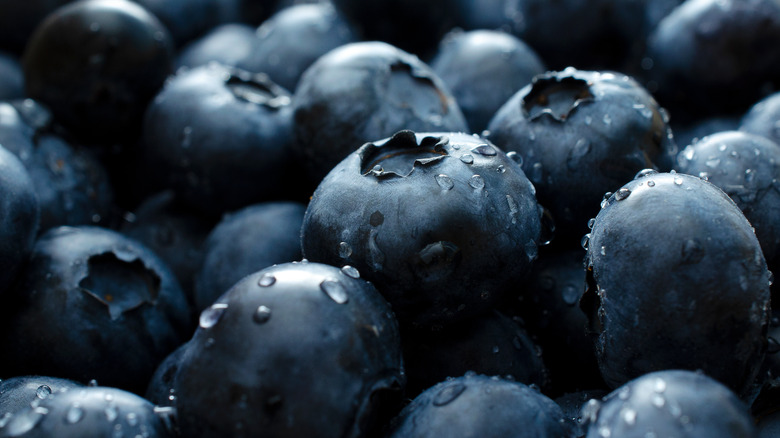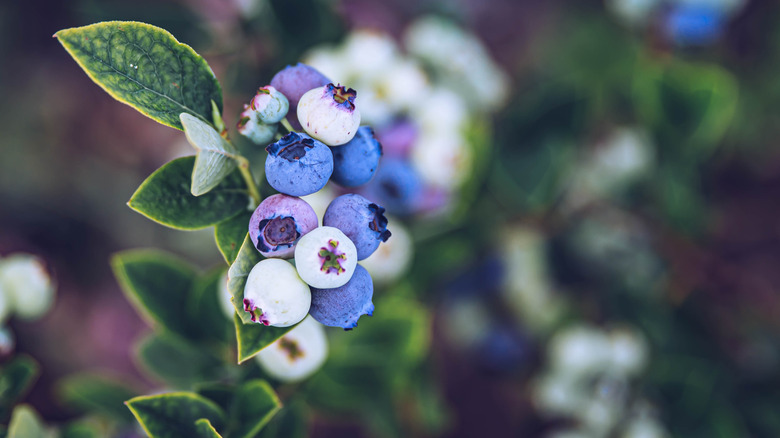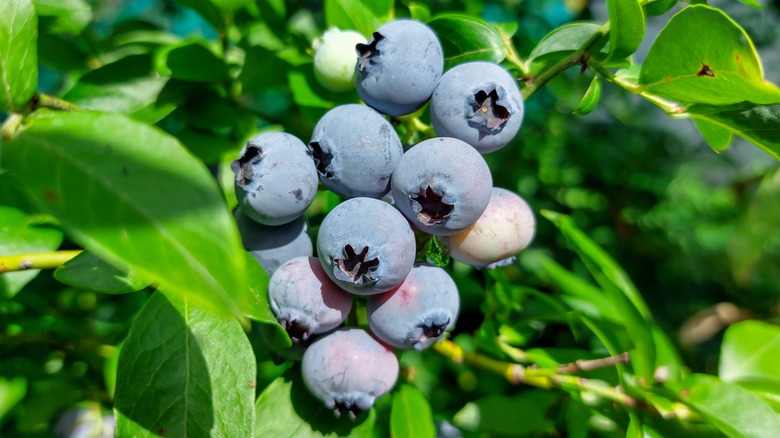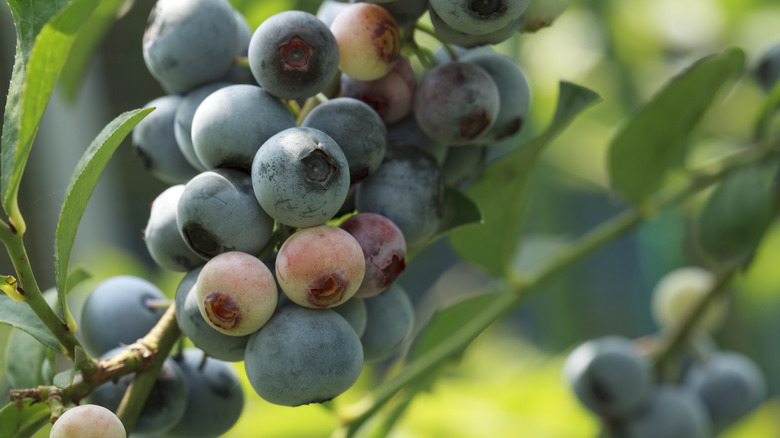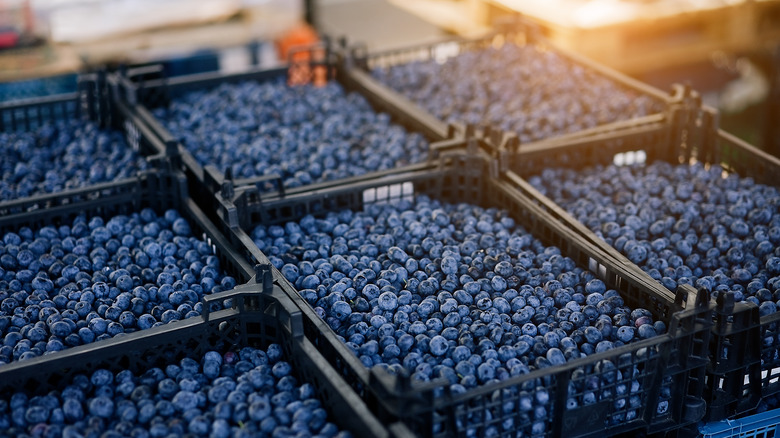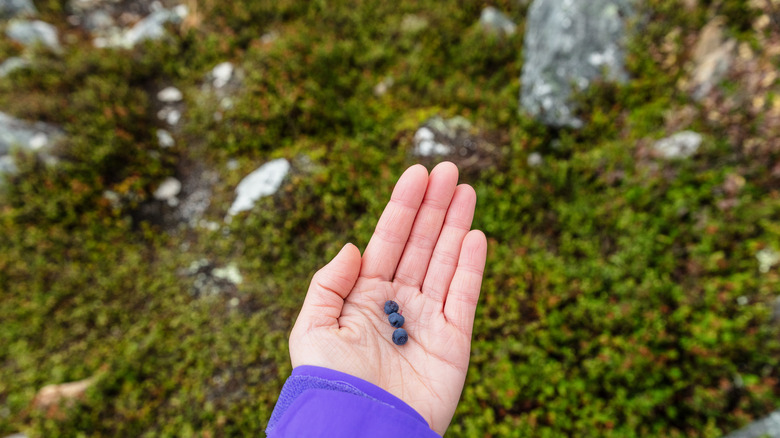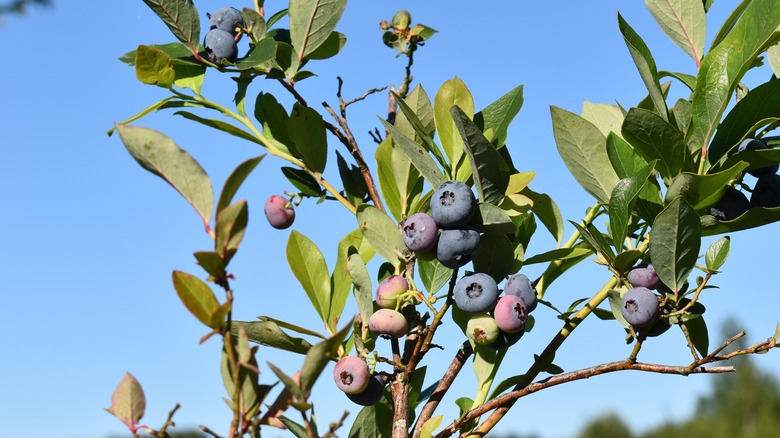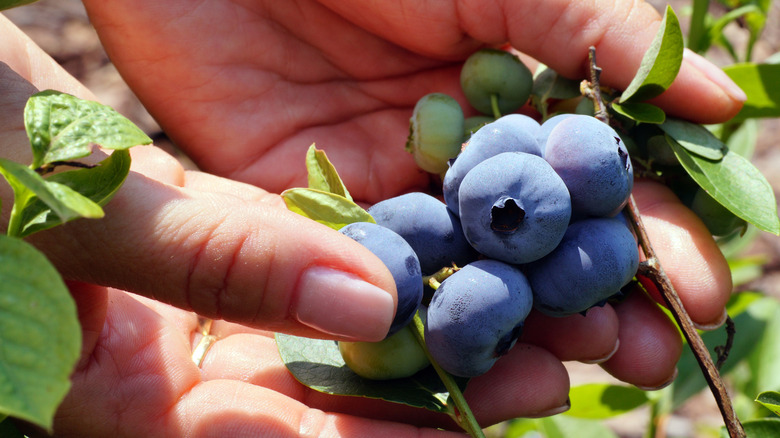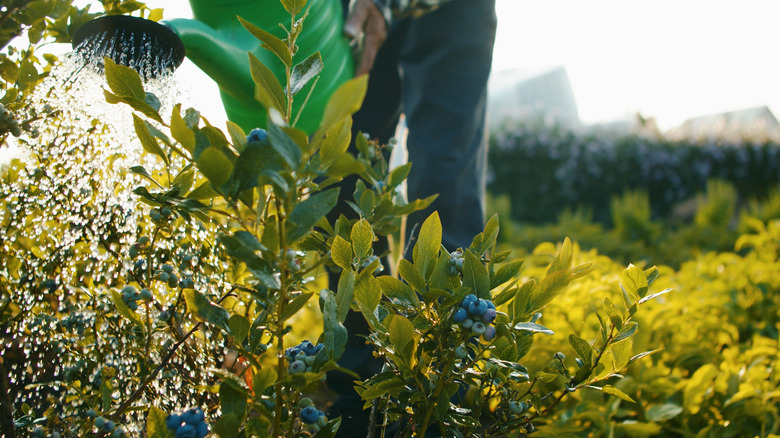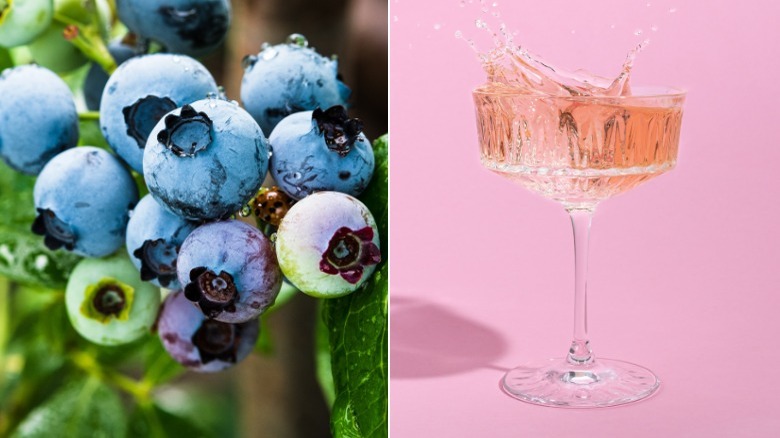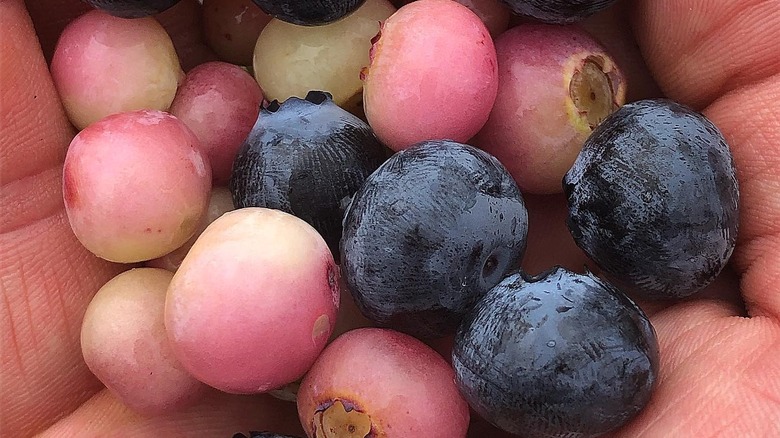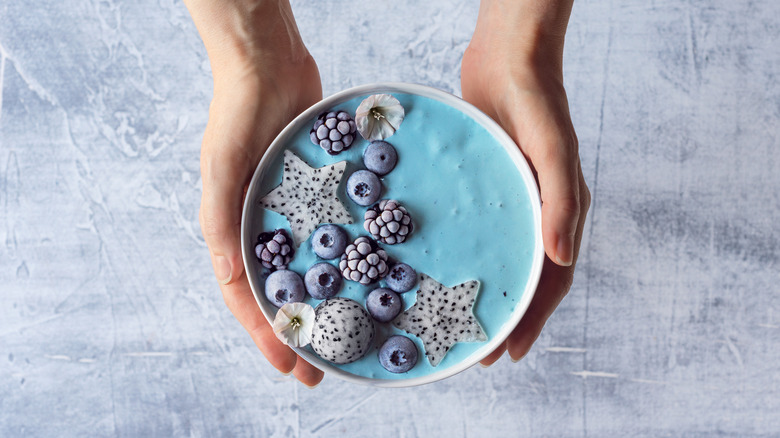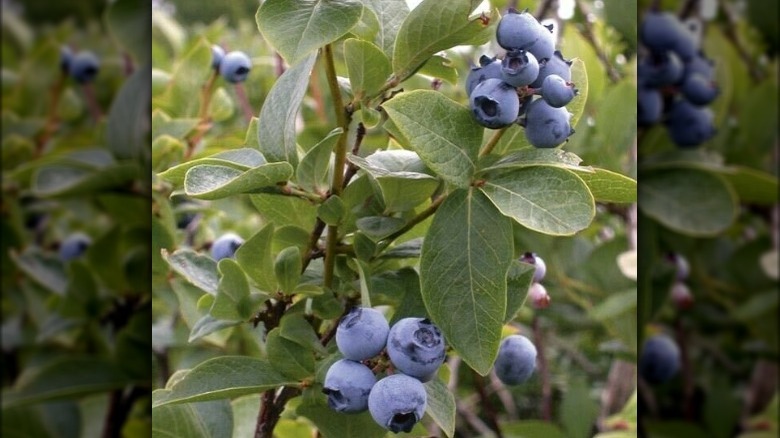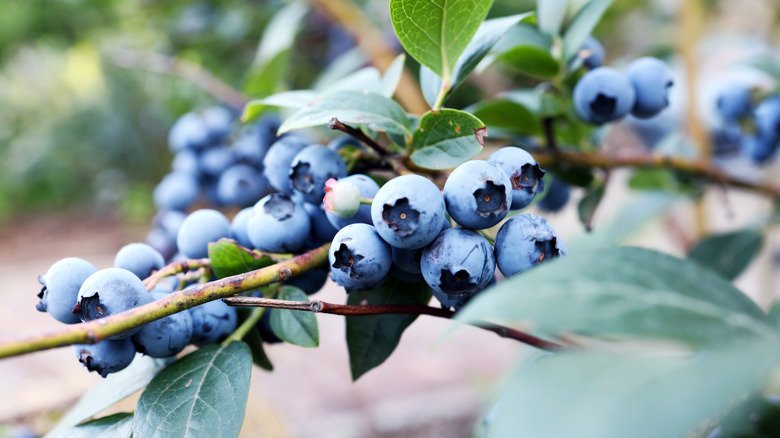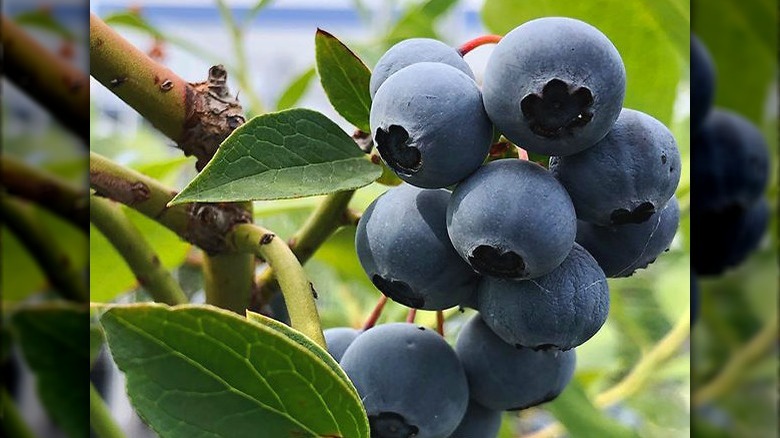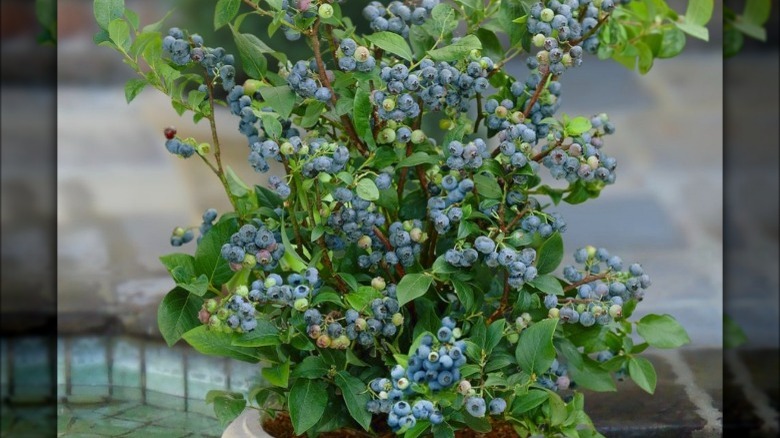15 Unique Blueberry Varieties You Should Know About
A blueberry is a blueberry, right? We think we know them. They're the plump, juicy berries that are blue and come into season right in the heart of summer — just in time for all your favorite desserts. We eat them in many things, from blueberry pies topped with fresh ice cream to blueberry cobblers hot from the oven.
They can be found growing wild across many regions of the United States and are surprisingly easy to grow at home. You can find farms selling them by the quart or more. As it turns out, there's a lot more to this small fruit than is apparent at first glance or first bite. There are about 150 different varieties of blueberry and the blueberry-adjacent bilberry, but not all of them are anything you'd want to eat. The edible, best-tasting blueberries make up about a quarter of these varieties.
So how do you know which variety is best for your intended use, and do you even know what blueberries you've been eating all these years? To help you become more acquainted with the amazing, often underestimated blueberry, here are some unique varieties that you should know about and cook with.
1. Lowbush blueberries
Edible blueberries can be broken down into several main categories, with many different berry varieties falling into these broader, overarching categories. One of these main categories is the lowbush category. The most simple explanation of lowbush blueberries? These are basically wild blueberries, even though you can cultivate lowbush blueberries on a farm or grow them at home.
If you've ever been on a hike where you've spotted small bushes with small-ish blueberries growing on them, and the bushes were only about as high as your calves, then those were likely lowbush blueberries. They're most commonly found in the northern part of the country, as they're very cold-hardy plants.
You might know lowbush blueberries more so as Maine blueberries, too, as lowbush blueberries are the state fruit of Maine and most foods purporting to be made from Maine blueberries use lowbush blueberries. Small and sweet, these blueberries may not be the best for straight snacking, as they're a little too small for that, but they'll make a great pie or cobbler.
2. Highbush blueberries
One of the other main categories of blueberries, highbush blueberries, is essentially the opposite of lowbush blueberries, which you might've guessed, thanks to these varieties' names. Highbush blueberries are often prized for how much fruit they can produce and how big the fruit grows, compared to what you'll get with a lowbush blueberry.
Additionally, highbush blueberry bushes are just larger in size, taller, and girthier compared to their wild siblings. Because of all this, highbush blueberries are a popular pick for growing blueberries commercially. Highbush blueberries can also be grown more widely than lowbush blueberries, so you might see them in areas of the country that are a little further south.
Because highbush blueberries are on the larger side, they're great for snacking straight from the fridge. However, you can really use these blueberries in a range of ways since they're so versatile. Baking, smoothies, sauces, savory dishes, and more all pair well with this variety.
3. Rabbiteye blueberries
The third and final major type of blueberry that you'll find in the United States, beyond highbush and lowbush, is the rabbiteye blueberry. Unlike lowbush blueberries, rabbiteye blueberries are often found in the South and are often grown commercially, though some home gardeners use this variety as a garden plant or as part of an edible ornamental garden.
If you're thinking of growing blueberries at home, this variety is easy to take care of, and you'll be rewarded with easy-to-pick, medium-sized blueberries that can be enjoyed in a variety of ways.
However you decide to enjoy your blueberries, if you just have too many on hand to eat at once, consider freezing your blueberries so that you can use them later. If you do freeze your blueberries, resist the urge to wash them before freezing, as that will remove the blueberries' natural protective coating. Just remember to clean them before use after thawing.
4. Half-high blueberries
Half-high blueberries are a genetic mix of lowbush blueberries and highbush blueberries. You'll find various types of half-high blueberries, making this blueberry variety more of a sub-category of the three major categories than an individual variety on its own.
A half-high blueberry bush blends the best parts of a highbush blueberry with the best parts of a lowbush blueberry. Think of a small bush size that's not going to take up a lot of space in your yard but has lots of berries on each and every bush, and big berries at that.
Additionally, half-high blueberry plants can handle certain weather conditions that highbush blueberry bushes just can't. So, when it comes to those big blueberries you see for sale in the store or at the farmers market, they may be highbush, or they may be half-high. If you're just eating the berries, you likely won't notice much of a difference.
5. Alaska blueberries
Alaska blueberries, which are — you guessed it — blueberries grown wild in Alaska, stand out because of their health benefits. According to the University of Alaska Fairbanks Cooperative Extension Service, the average cultivated blueberry scores 24 in the "oxygen radical absorption capacity test," which basically is just a test to measure antioxidant content.
If a food scores more than a 40 on the test, it's deemed a high-antioxidant food. Wild blueberries score higher than cultivated blueberries on this test, for more antioxidant power, with an average score of 61. However, under this test, Alaska blueberries outrank even the wild blueberries that will grow wild in the lower 48 states, with a score of 76.
And just for future reference, if you're looking for the healthiest blueberries possible, one of the highest-ranking blueberries, according to the oxygen radical absorption capacity test, is the dwarf blueberry, with a score of 85. It's worth noting that these numbers evolve as the blueberries are processed, so you might even be able to tap into more antioxidant goodness if you eat Alaska blueberries processed in certain ways, such as when dried or turned into fruit leather.
6. Duke blueberries
Duke blueberries are one of the types of blueberries to fall under the highbush blueberry category — and it's one of the top blueberry choices for farms that offer you-pick options, as this bush produces lots of fruit, overall, but also lots of berries that are the same large size. The one downside to this blueberry? The flavor is a little on the milder side and a bit more tart, so if you're looking for a big burst of sweet flavor, you might want to go with a lowbush variety, like Maine blueberries, even though they're smaller.
Because of this flavor, some growers recommend you don't eat the blueberries raw but, instead, freeze them or use them to make preserves or in cooked dishes. Luckily, there are plenty of ways to use blueberries, so you won't be at a loss for how to incorporate these healthful berries into your diet. In fact, since they're so versatile, you might want to consider eating blueberries every day – there are certainly enough reasons to support it.
7. Darrow's blueberries
The Darrow's blueberry is native to Florida. Despite its southern home, though, it's neither a highbush nor a rabbiteye blueberry variety. Instead, while highbush and rabbiteye bushes are deciduous, this blueberries' bushes are evergreen and happy in sandy soil. Differences aside, this blueberry variety is still edible, and some Floridians use this bush as part of their edible landscaping.
Darrow's blueberry bushes are, much like the lowbush blueberry variety bushes, on the smaller side, compared to the large, commercially friendly highbush and rabbiteye varieties. The fruit is on the larger side, with some berries growing as big as a quarter. The blueberries are easy to pick, dark blue in color, and sweet-tart in flavor.
If you look for this blueberry variety at your local farms market or you're on the hunt for a bush to add to your landscaping, just be sure that you don't confuse it with its similarly named blueberry sibling. Darrow's blueberry is called vaccinium darrowii, while a different, much larger highbush variety goes by vaccinium corymbosum darrow.
8. Top hat blueberries
Most lowbush blueberry bushes are small, but if you want a blueberry bush that's even smaller, look to the Top Hat blueberry, which can be cultivated in a flower pot. Just like the darrow's blueberry bush, though, Top Hat blueberry bushes, despite their small size, still produce average-sized berries like you might get from a highbush blueberry bush.
Developed in Michigan in the 1980s, the top hat blueberry was actually the result of crossing a highbush blueberry variety with a lowbush blueberry variety, creating the best of both worlds — small bushes with big berries. The berries themselves are known to be slightly sweet and slightly tart, a bit similar to a wild blueberry, with a lot of juice but a firm feel. Vibrantly blue, the berries are easy to pick and can be used in just about any way you like — in baking, savory cooked items, sauces, and more.
9. Pink Champagne blueberries
When it comes to super-unique blueberries, you can't overlook the pink Champagne blueberry, which stands out thanks to its pink color. Yes, while blueberries are literally named for their color, you can find blueberries that deviate away from their normal blue hue, like these, which are more of a light, delicate pink.
Unfortunately, while the allure of a pink blueberry is strong, and interest has been shown by both producers and consumers alike, it seems there are still some kinks being worked out with this particular agricultural offering.
In 2012, as The Old Farmer's Almanac reported, there was a recall of pink Champagne blueberry plants, as the U.S. Department of Agriculture found that some of the plants, despite sellers' claims, didn't actually produce pink berries. As part of the 2012 recall, the USDA advised buyers to return their plants and request a refund rather than be disappointed when harvest time arrived.
10. Pink popcorn blueberries
If you have your heart set on pink-hued blueberries, you don't need to be disappointed by the somewhat-unreliable nature of the pink Champagne blueberries. There are other true pink blueberry varieties out there, like the pink popcorn blueberry.
Although they tend to be more on the light pink side, as the summer goes on, the color does become a more vibrant pink. Eventually, the peak color is more of a pastel with magenta pink that is just too aesthetically pleasing to pass up. The berries are lightly sweet, which seems to fit the light color.
You can use these berries in just about any dish, snack, or drink that you would use with regular blueberries. However, given the color, you might want to hold off on hiding the berries inside a muffin or a smoothie. Instead, consider using this fruit to top your next cake for a creative, pretty-in-pink cake topper.
11. Powder Blue blueberries
Don't be fooled by the initial pink exterior these blueberries give off. As the name suggests, powder blue blueberries eventually turn a waxy-looking, light powder blue. However, at first, they're a pinkish color before they're in season.
This rabitteye blueberry variety was created by the U.S. Department of Agriculture and North Carolina State University in the 1970s. They're on the smaller side and pretty tart if you pick them too soon, but if you can wait until they're ripe in mid-summer, you'll be treated to a small berry that's just as delicious raw as it is when cooked or baked.
Try them in a blueberry juice that can be enjoyed on its own or as a part of another recipe that uses fruit juices, like homemade popsicles, or bake a blueberry crostata. In areas where rabbitteye blueberry varieties are prominent, you can find powder blue blueberries growing at you-pick operations, where the variety is often chosen because it produces berries over a relatively long period of time, allowing for more harvesting.
12. Biloxi blueberries
While there are many newer varieties of blueberries that have been introduced to the public over the last few decades, some varieties are much older, like the Biloxi blueberry. Named after the city in Mississippi, no one's quite sure how this blueberry came about, but it's a highbush variety that, in some ways, resembles a blackberry. For example, these blueberries are abnormally firm and have thicker skin, but they're still sweet.
Because these blueberries are so firm, with that thick skin, you might not want to eat them on their own or throw them on top of your granola. However, you might want to turn them into preserves or jam, bake them, or use them in any other way where they might undergo a little processing before eating.
Even if this is your first time hearing of this blueberry, you might've actually eaten one in the past — probably more than once. Biloxi blueberries can be found in store-bought cereals and snack foods.
13. Bluecrop blueberries
For the home gardeners out there who are admittedly not the greenest thumbs in the bunch, you might want to try your hand at growing the bluecrop blueberry. This blueberry variety is known to be extra-resilient, weathering both weather and plant diseases with ease.
Additionally, these blueberry bushes are high-yielding and quick to produce, compared to some blueberry varieties that don't actually produce any berries until they're a few years old. In fact, some bushes can produce as much as a whopping 20 pounds of blueberries each summer.
Bluecrop blueberries are a highbush variety and, sometimes, are just referred to as Northern highbush blueberries. They're also a very ancient variety of blueberry, with some believing that indigenous populations first cultivated the berries. The berries are also popular with wildlife when grown wild. In the past, the variety was one of the top, most popular among growers for all of the reasons listed above.
14. Brightwell blueberries
Brightwell blueberries are like the Bluecrop blueberry of the South, just a little bit younger. A type of rabbiteye blueberry, Brightwells are extremely hardy and, thus, popular. They also produce a large number of berries each year, though not quite 20 pounds — the yield is closer to 10 pounds, with very little maintenance.
The University of Georgia produced this variety of blueberries in the early 20th century. Brightwell blueberries are known for being mildly sweet and extra-juicy, and they're pretty much suitable for eating or cooking any way you like. While the blueberries are fresh, consider making one of the top recipes for in-season blueberries, like a blueberry bundt cake or blueberry-balsamic glazed rosemary chicken.
If you freeze or otherwise hold on to some of the berries into the fall, you can make recipes that take advantage of blueberries' health benefits any time of year. To get the most flavor out of your blueberries, consider pairing them with coriander — while it might seem like an odd combo, this herb always boosts blueberry flavors, whatever you're cooking.
15. Sunshine Blue blueberries
Sunshine blue blueberries aren't a variety that you'll often find in stores or at farm stands, given that the bushes don't really produce as much as some of the other varieties on our list, and the berries aren't quite as big as some others. Still, they are an excellent pick for home gardeners. The bushes can be grown in small spaces, and they're suitable for warm climates.
The sunshine blue blueberry was first created and then patented in the 1970s by a doctor attempting to create a new blueberry variety that fit his perfect flavor profile. Today, you'll find that flavor profile to be slightly tart. Because of the berry's reliable tartness, it makes a good choice for any recipe where you don't want things to be overly sweet.
They also work well in dishes that might benefit from a wide range of flavors, like fresh grain bowls or salads. Combining tart fresh blueberries with other toppings like cacao, bee pollen, coconut chips, and nut butter can also instantly elevate your smoothie bowls.
